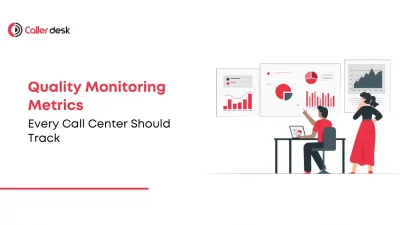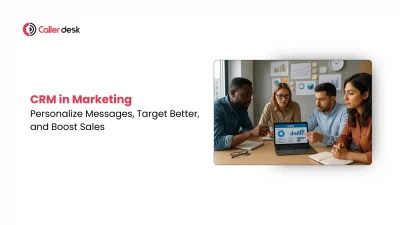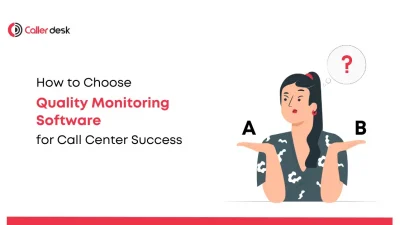Have you ever wondered why some call centers consistently deliver exceptional customer service while others struggle to meet expectations? The difference often lies in having a well-defined Quality Monitoring (QM) strategy. Without it, even the most skilled agents may falter, leaving customers dissatisfied and impacting your brand’s reputation.
This comprehensive guide is tailored for call center managers, supervisors, and agents seeking to elevate operational efficiency, boost customer satisfaction, and maintain high-quality service standards. From setting clear goals to leveraging cutting-edge tools, learn how to implement a winning Quality Monitoring strategy that ensures consistent excellence.
What Is Quality Monitoring?
Quality Monitoring (QM) in a call center is the systematic process of evaluating customer-agent interactions to ensure adherence to predefined performance standards. By reviewing call recordings, analyzing real-time interactions, and assessing performance metrics, QM identifies strengths and improvement areas within your team.
Key Objectives of Quality Monitoring:
- Ensure Consistency: Deliver a uniform experience across all customer interactions.
- Improve Performance: Provide actionable feedback to enhance agent skills and productivity.
- Enhance Customer Satisfaction: Create positive experiences that boost loyalty and retention.
- Compliance Assurance: Maintain adherence to industry regulations and company policies.
Why QM Matters for Customer Experience:
- Proactive Problem Solving: QM helps detect recurring issues and enables businesses to resolve them before they escalate.
- Customer-Centric Approach: By focusing on customer feedback and interaction trends, QM ensures every call aligns with customer expectations.
- Stronger Brand Loyalty: Delivering consistent quality fosters trust, ensuring customers remain loyal to your brand.
Why Is Quality Monitoring Crucial for Call Centers?
With increasing customer expectations and competition, maintaining high service standards is non-negotiable. QM empowers call centers to continuously improve, adapt to changing customer needs, and stay ahead in the competitive landscape.
The Key Benefits of QM:
- Customer Retention and Loyalty: Studies show that 86% of customers are willing to pay more for excellent customer service. QM ensures interactions consistently meet or exceed expectations.
- Boosted Agent Performance: Regular feedback leads to a 30% improvement in agent productivity and engagement.
- Reduced Costs: Identifying inefficiencies and improving first-call resolution rates can reduce operational expenses by 15-20%.
- Compliance Assurance: QM ensures adherence to industry regulations like GDPR, HIPAA, or PCI DSS, protecting your business from legal risks.
- Actionable Insights: Data-driven analysis helps refine training programs, optimize processes, and address recurring challenges.
Steps to Implement an Effective Quality Monitoring Strategy
Implementing an effective QM strategy requires a structured approach and the right tools. Here are the essential steps:
1. Define Clear Goals and KPIs
A strong QM strategy begins with clearly defined objectives. Use the SMART framework to set goals that are Specific, Measurable, Achievable, Relevant, and Time-bound.
Examples of SMART Goals:
- Customer Satisfaction (CSAT): Achieve a 90% CSAT score by the end of the quarter.
- First-Call Resolution (FCR): Increase FCR rates by 15% within six months.
- Average Handle Time (AHT): Reduce AHT to under 4 minutes in the next quarter.
2. Foster Transparency with Agents
Agents are the backbone of your call center. To ensure their buy-in, communicate the purpose and benefits of QM clearly. Share evaluation criteria such as:
- Communication tone and empathy.
- Adherence to scripts and guidelines.
- Problem resolution efficiency.
Transparent communication creates trust, reduces resistance, and fosters a culture of continuous improvement.
3. Leverage Advanced Monitoring Tools
Investing in the right tools is critical for effective QM. Advanced software solutions, like CallerDesk, offer robust features to streamline monitoring processes.
Key Features of CallerDesk QM Tools:
- AI-Powered Sentiment Analysis: Detect customer emotions and gauge interaction quality.
- Customizable Dashboards: Track KPIs in real time for quick decision-making.
- Call Recording and Playback: Enable detailed reviews of customer interactions.
- Speech Analytics: Automatically identify recurring issues or agent performance gaps.
4. Analyze Data for Trends and Insights
Data-driven decision-making is at the heart of successful QM strategies. Use analytics to identify:
- Recurring customer pain points.
- Trends in agent performance over time.
- Opportunities for process optimization.
For instance, if data shows a spike in escalations during peak hours, consider adding more agents or enhancing self-service options to manage the load.
5. Deliver Timely Feedback and Coaching
Feedback is most effective when it’s timely and constructive. Schedule regular one-on-one sessions with agents to:
- Highlight strengths (e.g., “Your patience with frustrated customers is commendable.”).
- Address areas for improvement (e.g., “Consider simplifying explanations for technical issues.”).
Use coaching sessions to equip agents with the skills they need to excel, such as role-playing difficult scenarios or attending communication workshops.
6. Schedule Regular Evaluations
Consistency is key to sustained quality. Develop a structured monitoring schedule, such as:
- Weekly evaluations for new agents.
- Monthly reviews for experienced agents.
Regular evaluations help identify issues early and reinforce positive behaviors.
7. Perform Calibration Sessions
Calibration ensures fairness and consistency in evaluations. By aligning evaluators’ scoring methods, you minimize bias and maintain uniform standards across the team.
8. Focus on Compliance
Compliance isn’t optional, especially in industries like healthcare or finance. Use QM to monitor adherence to regulations, ensuring your agents handle sensitive customer data responsibly.
9. Build a Continuous Feedback Loop
A strong feedback loop is essential for continuous improvement. Combine evaluations, coaching, and agent feedback to create a system that evolves with your business needs.
CallerDesk: The Ultimate Solution for Quality Monitoring
CallerDesk offers state-of-the-art tools to simplify and enhance your QM strategy. Whether you’re managing a small team or a large enterprise, CallerDesk’s cloud-based solutions empower you to monitor and optimize performance effortlessly.
Why Choose CallerDesk?
- Customizable Solutions: Tailor QM processes to align with your specific goals and industry requirements.
- Real-Time Insights: Access up-to-date metrics to identify improvement areas immediately.
- Scalable Features: Expand functionality as your business grows.
- Seamless Integration: Connect CallerDesk tools with existing CRM or business software for enhanced productivity.
- Enhanced Agent Engagement: Gamified dashboards and rewards systems make monitoring engaging for agents.
Conclusion
A robust Quality Monitoring strategy is the cornerstone of exceptional customer service and efficient call center operations. By setting clear goals, leveraging advanced tools like CallerDesk, and fostering a culture of transparency and continuous improvement, you can unlock your call center’s full potential.
Take the First Step Towards Excellence
Ready to transform your call center performance? Schedule a free demo with CallerDesk today and discover how our cutting-edge tools can revolutionize your Quality Monitoring strategy.
Frequently asked questions
1. What is Quality Monitoring in a call center?
Quality Monitoring (QM) is the process of evaluating customer-agent interactions to ensure that agents meet predefined service standards. It involves reviewing calls, analyzing metrics, and offering actionable feedback to improve performance and enhance customer satisfaction.
2. Why is Quality Monitoring important for call centers?
Quality Monitoring helps ensure high service standards, improves agent performance, identifies process inefficiencies, and boosts customer satisfaction. It also aids in regulatory compliance and provides valuable insights for continuous improvement.
3. What tools are needed for effective Quality Monitoring?
Effective QM requires tools such as call recording software, real-time analytics platforms, sentiment analysis tools, and customizable dashboards. Solutions like CallerDesk integrate these features to streamline the monitoring process.
4. How often should calls be monitored in a call center?
Regular monitoring is recommended—weekly for new agents and monthly for experienced staff. This ensures consistent performance, addresses issues proactively, and maintains high-quality customer service.
5. Can Quality Monitoring improve customer satisfaction?
Yes, by identifying and addressing areas where agents can improve, QM ensures that customer interactions are more positive, efficient, and satisfying, ultimately leading to higher customer retention rates.
6. What are some common KPIs used in Quality Monitoring?
Key performance indicators (KPIs) include First Call Resolution (FCR), Average Handle Time (AHT), Customer Satisfaction Score (CSAT), and Net Promoter Score (NPS).
7. How does CallerDesk enhance Quality Monitoring?
CallerDesk offers advanced tools such as AI-powered sentiment analysis, customizable dashboards, and real-time analytics. These features make it easier to evaluate performance, provide timely feedback, and improve overall service quality.
8. Is Quality Monitoring necessary for compliance?
Yes, especially in industries like healthcare, finance, and insurance, QM ensures agents adhere to regulatory requirements, protecting sensitive customer data and avoiding legal risks.
9. What are calibration sessions in Quality Monitoring?
Calibration sessions align evaluators on scoring methods to ensure fairness and consistency when assessing agent performance. These sessions eliminate bias and improve the reliability of feedback.
10. Can Quality Monitoring be automated?
Yes, automation through AI and speech analytics can streamline QM by identifying trends, analyzing customer sentiment, and detecting areas for improvement with minimal manual effort.





